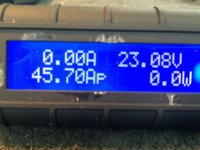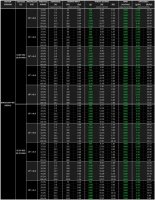You are using an out of date browser. It may not display this or other websites correctly.
You should upgrade or use an alternative browser.
You should upgrade or use an alternative browser.
KDE vs T-Motor -- Picking a Motor Based on Spec Sheets
- Thread starter econfly
- Start date
econfly
Member
In my previous career when I was selecting motors, gearboxes, chain, belt and gear drives for industrial applications I could always count on
The specific drive to work as intended unless I made a bad calculation. (Which I didn't because I tripple checked numbers)
I made many mistakes selecting motors and esc's for my hex. Was I at fault or were the numbers a little off???
Based on what I found some numbers are better than others...
Pumpkinguy
Member
I'd like to see what you find for amp draw.
Here are my results for the 4215-465
16" prop. View attachment 24458
18" prop. View attachment 24459
Here are my results for the 4215-465
16" prop. View attachment 24458
18" prop. View attachment 24459
Attachments
econfly
Member
I'd like to see what you find for amp draw.
Every motor I have ever tested pulls more amps than the spec at full throttle if the voltage provided is above nominal 3.7v per cell. Both of these motors exceeded rated amps and thrust at full throttle and on a fully charged battery (4.2v per cell). Check out the data points in my test graph. Note that highest watts measured on both motors is well to the right of the highest spec data point.
Pumpkinguy
Member
I for one would rather see a company post specifications on the low side. That way we will not be put in a position to make a bad selection (costing us $$$$$$$ and time) and will never be disappointed.
When I bought my 4215's this was the spec sheet. It has since been changed.View attachment 24464
When I bought my 4215's this was the spec sheet. It has since been changed.View attachment 24464
Attachments
Last edited by a moderator:
fltundra
Member
Same here.When I bought my 4215's this was the spec sheet. It has since been changed.
Last edited by a moderator:
Pumpkinguy
Member
I got these with 55amp esc. I quickly found out I needed 75+ esc. Now I'm in the position where I feel I ordered the wrong motor. I really need the 5215's. For my own peace of mind. I would swear but all you guys would see is a bunch of *************. lol.
Motopreserve
Drone Enthusiast
Has anyone used their calculator? I wonder if it would spit out a different motor suggestion than the spec sheets might lead one to buy?
Pumpkinguy
Member
The only discrepancy I had with the KDE specs, were when it came to grams per watt. Otherwise all the specs are right on with my results with tmotor 14x4.8's. Spec for 515 shows about 12 gpw, and actual is 9.5 gpw. 2480 AUW 260 watt hover. 59% SuperX blackbox.
I love that black box
econfly
Member
The only discrepancy I had with the KDE specs, were when it came to grams per watt. Otherwise all the specs are right on with my results with tmotor 14x4.8's. Spec for 515 shows about 12 gpw, and actual is 9.5 gpw. 2480 AUW 260 watt hover. 59% SuperX blackbox.
That's about what I am seeing. KDE's thrust values are inflated by about 25%.
Pumpkinguy
Member
But your saying they use 25% more watts rather than 25% less thrust?That's about what I am seeing. KDE's thrust values are inflated by about 25%.
Could a more efficient prop eat up some of that 25?
fltundra
Member
Tmotor CF's?For any given level of watts the KDE motor produced about 25% less thrust than their spec sheet claims for the prop size I tested.
Pumpkinguy
Member
Dji 1552's.Tmotor CF's?
econfly
Member
Yes, 1552s. But, for the purposes of this exercise all that matters is that both motors are spinning the same 15" prop. Back to my original post, this is really just a question of RPMs per watt given some load (in this case 15" folding props). For any given RPM, and regardless of the motor, the thrust is the same. What I compared today was the thrust per watt over several samples along the curve, but I could have just as easily measured RPM per watt and found the same essential result.
The result is that T-Motor and KDE are making fine motors/ESCs that turn power into revolutions about equally well. Really, there isn't much surprise in that. There is only so much one can do to push the efficiency of a brushless motor.
What is surprising is that KDE claims to make motors that are substantially more efficient. But those claims are not evidently true. As I noted in the first post, I think KDE's motor is probably the best motor for my use. They just exaggerate performance while T-Motor does not. You simply can't compare motors from these two makers on paper.
The result is that T-Motor and KDE are making fine motors/ESCs that turn power into revolutions about equally well. Really, there isn't much surprise in that. There is only so much one can do to push the efficiency of a brushless motor.
What is surprising is that KDE claims to make motors that are substantially more efficient. But those claims are not evidently true. As I noted in the first post, I think KDE's motor is probably the best motor for my use. They just exaggerate performance while T-Motor does not. You simply can't compare motors from these two makers on paper.
Can Uluc Birguler
New Member
kde4215xf-465 maximum thrust is seen to be higher than your T-P plot :/



